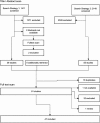Parameters Pointing at an Increased Risk for Contralateral Hip Fractures: Systematic Review
- PMID: 26929857
- PMCID: PMC4748160
- DOI: 10.1177/2151458515618490
Parameters Pointing at an Increased Risk for Contralateral Hip Fractures: Systematic Review
Abstract
Background: Early identification of hip fracture (HF) patients bearing an increased risk for a contralateral occurrence would allow providing preventive measures timely.
Objectives: To summarize the available evidence describing risk scores, prognostic instruments, or (groups of) parameters predicting contralateral HFs at the time point of the first fracture. Methods/Systematic Review: Articles were identified through searches in MEDLINE and Scopus from inception to April 2014, checking of reference lists of the included studies and reviews. One reviewer assessed all articles for inclusion and abstracted the data. Uncertain cases were discussed and decided with a second reviewer. Salient study and population characteristics were abstracted for each article. Studies reporting the association of a set of risk factors for second HFs were further examined and compared. The number of studies reporting on a risk parameter was assessed.
Results: Searches identified 3560 records, and 47 studies were included in this review. There was a large spectrum of study designs, patient populations, and follow-up periods. Among 11 studies reporting on a set of parameters, female gender was assessed most commonly (7 times), followed by age (5) and parameters of general health, vision, and stroke (each 4 times). We were unable to depict stringent patterns of risk parameters to be used for decision making in clinical practice.
Conclusions: The findings of this article call for a conjoint effort to achieve an expert consensus regarding a critical set of parameters for a risk instrument identifying patients bearing an increased risk for contralateral HFs early.
Keywords: contralateral hip fractures; geriatrics; osteoporosis; risk prediction; systematic review.
Conflict of interest statement
Figures
Similar articles
-
Expert Consensus on Predictive Parameters for the Occurrence of a Fall and a Contralateral Hip Fracture 1 and 3 Years After Hip Fracture: A Delphi Survey.Geriatr Orthop Surg Rehabil. 2017 Jun;8(2):94-98. doi: 10.1177/2151458516687811. Epub 2017 Jan 1. Geriatr Orthop Surg Rehabil. 2017. PMID: 28540114 Free PMC article.
-
The Effectiveness of Integrated Care Pathways for Adults and Children in Health Care Settings: A Systematic Review.JBI Libr Syst Rev. 2009;7(3):80-129. doi: 10.11124/01938924-200907030-00001. JBI Libr Syst Rev. 2009. PMID: 27820426
-
Association between pacifier use and breast-feeding, sudden infant death syndrome, infection and dental malocclusion.JBI Libr Syst Rev. 2005;3(6):1-33. doi: 10.11124/01938924-200503060-00001. JBI Libr Syst Rev. 2005. PMID: 27819973
-
Identifying and reducing the incidence of post discharge Venous Thromboembolism (VTE) in orthopaedic patients: a systematic review.JBI Libr Syst Rev. 2012;10(28 Suppl):1-14. doi: 10.11124/jbisrir-2012-315. JBI Libr Syst Rev. 2012. PMID: 27820401
-
Patient characteristics and risk of subsequent contralateral hip fracture after surgical management of first fracture.Injury. 2014 Oct;45(10):1620-3. doi: 10.1016/j.injury.2014.05.030. Epub 2014 Jun 2. Injury. 2014. PMID: 24947502
Cited by
-
Impact of Stroke History on the Risk of Recurrent Hip Fracture or Major Osteoporotic Fractures among Patients with Incident Hip Fracture: A Nationwide Cohort Study.J Bone Miner Res. 2023 Feb;38(2):278-287. doi: 10.1002/jbmr.4760. Epub 2022 Dec 30. J Bone Miner Res. 2023. PMID: 36533810 Free PMC article.
-
Expert Consensus on Predictive Parameters for the Occurrence of a Fall and a Contralateral Hip Fracture 1 and 3 Years After Hip Fracture: A Delphi Survey.Geriatr Orthop Surg Rehabil. 2017 Jun;8(2):94-98. doi: 10.1177/2151458516687811. Epub 2017 Jan 1. Geriatr Orthop Surg Rehabil. 2017. PMID: 28540114 Free PMC article.
-
The impact of sequential therapy from short-term teriparatide to denosumab compared with denosumab alone in patients with osteoporotic hip fracture: a 1-year follow-up study.BMC Musculoskelet Disord. 2020 Nov 14;21(1):751. doi: 10.1186/s12891-020-03771-8. BMC Musculoskelet Disord. 2020. PMID: 33189148 Free PMC article.
-
Prophylactic augmentation of the osteoporotic proximal femur-mission impossible?Bonekey Rep. 2016 Dec 7;5:854. doi: 10.1038/bonekey.2016.86. eCollection 2016. Bonekey Rep. 2016. PMID: 28018586 Free PMC article. Review.
-
Expert consensus on relevant risk predictors for the occurrence of osteoporotic fractures in specific clinical subgroups - Delphi survey.BMC Rheumatol. 2019 Nov 12;3:50. doi: 10.1186/s41927-019-0099-y. eCollection 2019. BMC Rheumatol. 2019. PMID: 31742245 Free PMC article.
References
-
- Ryg J, Rejnmark L, Overgaard S, Brixen K, Vestergaard P. Hip fracture patients at risk of second hip fracture: a nationwide population-based cohort study of 169,145 cases during 1977-2001. J Bone Miner Res. 2009;24(7):1299–1307. - PubMed
-
- Liem IS, Kammerlander C, Suhm N, et al. Identifying a standard set of outcome parameters for the evaluation of orthogeriatric co-management for hip fractures. Injury. 2013;44(11):1403–1412. - PubMed
-
- Moher D, Liberati A, Tetzlaff J, Altman DG. Preferred reporting items for systematic reviews and meta-analyses: the PRISMA statement. Ann Intern Med. 2009;151(4):264–269, w264. - PubMed
-
- Chiu KY, Pun WK, Luk KD, Chow SP. Sequential fractures of both hips in elderly patients—a prospective study. J Trauma. 1992;32(5):584–587. - PubMed
-
- Ip D, Ip FK. Elderly patients with two episodes of fragility hip fractures form a special subgroup. J Orthop Surg (Hong Kong). 2006;14(3):245–248. - PubMed
LinkOut - more resources
Full Text Sources
Other Literature Sources
Research Materials
Miscellaneous


